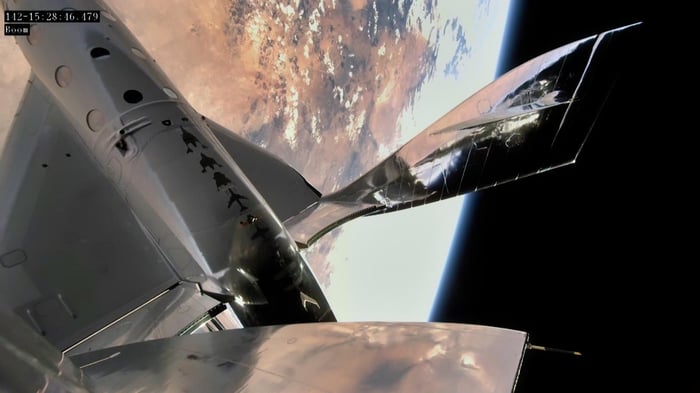Three months ago, Virgin Galactic (SPCE 3.48%) dropped a bombshell: Its long-awaited third rocket-powered trip to space -- the one that was expected to bring the company within just months of initiating commercial space tourism flights, and selling space tourism tickets -- would not take place as planned. Instead, Virgin Galactic would postpone its test-flying until May 2021, while it worked to fix a problem with electromagnetic interference (EMI) that had disrupted a test flight in December.
Well, good news: Last week, Virgin Galactic declared the EMI problem fixed. And on Saturday, Virgin Galactic proved it with a successful return to space.

VSS Unity back in space, May 22, 2021. Image source: Virgin Galactic.
Taking off from Spaceport America in New Mexico at 10:35 am EDT this morning, Virgin's VMS Eve mothership carried its VSS Unity spaceplane to an altitude of 44,000 feet.
Take off! VMS Eve and VSS Unity have taken to the skies above Spaceport America, New Mexico. #VirginGalactic
— Virgin Galactic (@virgingalactic) May 22, 2021
There, at 11:27 a.m., VMS Eve's pilots declared "Release, release, release!" and detached VSS Unity to begin its trip to space.
Release, release, release! VSS Unity has successfully separated from VMS Eve. #VirginGalactic
— Virgin Galactic (@virgingalactic) May 22, 2021
VSS Unity's engine ignited and fired for three full minutes before shutting down at 11:30 a.m. EDT and letting VSS Unity coast the rest of the way to apogee in space.
Rocket motor shutdown. Momentum will keep VSS Unity travelling upwards toward apogee. #VirginGalactic
— Virgin Galactic (@virgingalactic) May 22, 2021
Two minutes later, gravity reasserted its hold over the craft, and VSS Unity began its descent back to Earth, touching back down at Spaceport America at 11:43 a.m. EDT.
Touch down, VSS Unity. #VirginGalactic #UNITY21
— Virgin Galactic (@virgingalactic) May 22, 2021
In all, the test flight consumed just one hour, eight minutes start to finish. But as a result of it, this former SPAC stock -- that is, the stock of a special-purpose acquisition company -- is back in space, as well as back in the race to become the first company to begin commercial space tourism operations.





